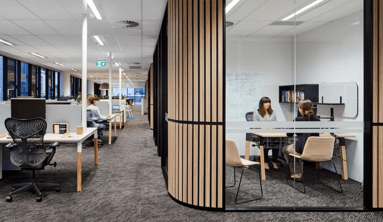Creating engaging workplace experiences for tech employees
In today's tech-driven landscape, employers must create spaces that accommodate various work modes, from team collaboration to focused individual tasks.
Understanding and addressing tech professionals' evolving needs and preferences is crucial to enhancing employee engagement in the hybrid world.
Aligning tech employees’ needs with employer perceptions
of employees would prefer to have separate space for collaborative and quiet work
Employees in the tech sector are eager for more areas for dedicated, focused work. According to our Global Workplace Insights research, 81% of employees in the tech industry prefer to have separate spaces for collaborative and quiet work.
of employers think that good amenities are a key factor motivating employees to want to spend more time in the office
However, there's a significant gap between employee preferences and employer perceptions. While 93% of employers believe that good amenities motivate employees to spend more time in the office, they may need to pay more attention to the importance of providing dedicated spaces for focused work.
Balancing focus with flexibility
The ideal workplace for the tech industry should feature dedicated zones that cultivate deep focus while balancing collaborative spaces with individual workstations. By establishing such an environment, companies can significantly enhance employee engagement, fostering a culture of productivity and innovation. This approach acknowledges the diverse work preferences among employees, ensuring that everyone has access to the space that best suits their working style, ultimately leading to higher job satisfaction and retention rates.
To truly resonate with tech employees' desires for flexibility in their workplace experience, it's crucial to move beyond the conventional "neighborhood" model. Introducing allocated spaces where employees can choose their experience based on auditory, immersion, kinetic, and flow principles blurs the lines between work and play. This approach not only diversifies the work environment but also promotes a more inclusive and engaging learning and working experience, catering to the dynamic needs of today's workforce.

DoubleVerify’s office strategically layers collaborative spaces with heads down rooms for focus work—accommodating a hybrid workforce that allows everyone to be productive.
The rise of the fourth workspace
Looking towards the future, the rapid advancements in technology, notably the integration of virtual reality (VR) and the Metaverse, are set to redefine the concept of the workplace.
We foresee that sector as pioneers in normalizing VR/Metaverse as a collaborative tool to introduce the "4th workspace," expanding the traditional workspace spectrum to include home, remote, office, and now, virtual environments. This evolution required a reimagining of spatial designs to accommodate this new dimension, offering exciting opportunities for workspace innovation that transcends physical boundaries and fosters a work culture that seamlessly blends the physical and virtual realms.
As the tech sector evolves, understanding and implementing these key considerations in workplace design will be instrumental in attracting and retaining top talent.

Seismic’s office is a futureproofed hybrid work environment with integrated technology that engages employees remotely and in the workplace.


